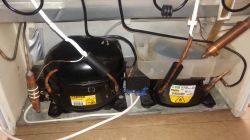Hello, I would like to start my adventure with refrigerators, as I was interested in building a fridge after purchase.
Well, the fridge is Liebheer KGT 3946 on the R600a.
The fridge is high, so unfortunately I decided to transport lying down.
And here people have different opinions.
Some of that on the suction side, others that the press and the admin AGD writes that it does not matter, until the refrigerator is not "upside down".
As this refrigerator has two compressors and unfortunately set up oppositely, there was no choice, you had to choose one of two - a necessary evil.
I bought the fridge, I could not check it, it was already turned off, the freezer was still cold (already defrosted), but the fridge was not.
Well, but to the point. After transport to the destination and waiting 24 hours, the refrigerator was connected to the network.
The effect is that both compressors turn on (both are very hot), the super cooler freezes, the wires coming out of the compressor also and the heat sink on the back of the refrigerator responsible for the freezer too.
However, the compressor responsible for the fridge also works hot, but the wires coming out of it are not. It seems to me that the cooling wall inside the refrigerator is slightly colder than the inside of the refrigerator.
The fridge is cool and I would like to experiment with it.
I would like to ask you in what order and what to diagnose.
I have some experience in air conditioning, I have a vacuum pump, pressure gauges, and a brazing kit.
I add a picture of the compressors, I will add that the refrigerator was transported on the left side looking from the back, because this side was already scratched (most likely from the previous transport by the previous owner).
Well, the fridge is Liebheer KGT 3946 on the R600a.
The fridge is high, so unfortunately I decided to transport lying down.
And here people have different opinions.
Some of that on the suction side, others that the press and the admin AGD writes that it does not matter, until the refrigerator is not "upside down".
As this refrigerator has two compressors and unfortunately set up oppositely, there was no choice, you had to choose one of two - a necessary evil.
I bought the fridge, I could not check it, it was already turned off, the freezer was still cold (already defrosted), but the fridge was not.
Well, but to the point. After transport to the destination and waiting 24 hours, the refrigerator was connected to the network.
The effect is that both compressors turn on (both are very hot), the super cooler freezes, the wires coming out of the compressor also and the heat sink on the back of the refrigerator responsible for the freezer too.
However, the compressor responsible for the fridge also works hot, but the wires coming out of it are not. It seems to me that the cooling wall inside the refrigerator is slightly colder than the inside of the refrigerator.
The fridge is cool and I would like to experiment with it.
I would like to ask you in what order and what to diagnose.
I have some experience in air conditioning, I have a vacuum pump, pressure gauges, and a brazing kit.
I add a picture of the compressors, I will add that the refrigerator was transported on the left side looking from the back, because this side was already scratched (most likely from the previous transport by the previous owner).




